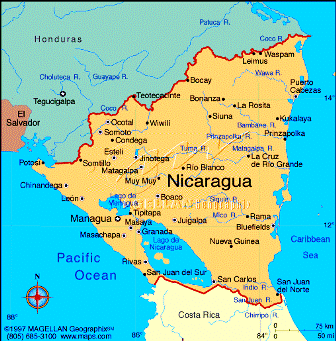| Friday 1 April
2005, Liberia, Costa Rica The countdown to the end of
our trip has begun. We have about three weeks left and we
now have to plan a bit better in order to fit everything
we want to see and do into our remaining time. We have
enjoyed all the countries we have visited so far although
we found the cities in Nicaragua a bit too hot,
especially since our grade of hotel rarely has air
conditioning.
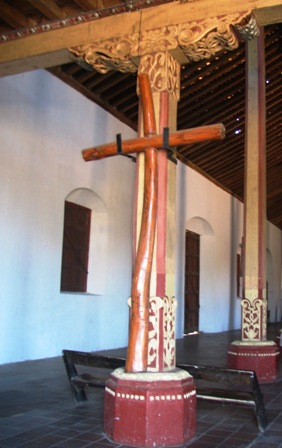 Leon was the first city in
Nicaragua where we basically laid low in the afternoon.
We would do our walking tour of the many churches in the
morning, then return to our hotel and sit under the fan
until the temperature moderated in the evening. Leon was the first city in
Nicaragua where we basically laid low in the afternoon.
We would do our walking tour of the many churches in the
morning, then return to our hotel and sit under the fan
until the temperature moderated in the evening.
Our favourite restaurant faced the main plaza. One
evening a group of Nicaraguans was enjoying some beers
and food at a sidewalk table when a group of Mariachi
style musicians came by. The Nicaraguans, who knew all
the songs and sang along, encouraged the group to play
for quite a while. The Nicaraguans had a great time and
we were sorry when they finally left.
A beach
holiday sounded like a great way to beat the heat of the
city. We took a bus to Las Peņitas, a short distance
south of Leon. We stayed at the very nice small hotel,
Barca de Oro, owned by a French woman, Sandrine, and her
Nicaraguan husband. Their hotel is at the junction of a
white sand beach and the mouth of a mangrove lined river
leading into the Isla Juan de Venado nature reserve.
The tides are
quite high on that coast and the waves break continually
on the shore. At low tide the fishermen's boats are left
high and dry on the sand. As soon as the tide starts to
come in, the fishermen get together to push their boats
into the advancing waters and make their way through
heavy seas to start their daily fishing.
The sea was nice and warm and the waves were perfect
for boogie boarding. Barca de Oro had boards for guests
to use so we had a great time renewing the skills we
learned in Australia last year.
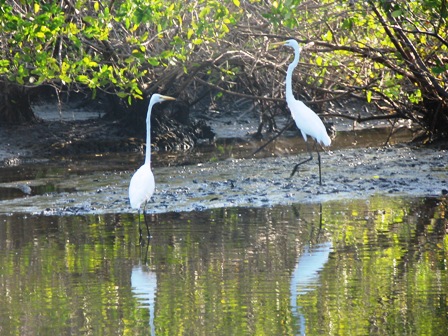 We took
an early morning boat ride up the river into Isla Juan de
Venado park. The narrow channel of river cuts off the 20
km island from the mainland. There weren't nearly as many
birds as Crooked Tree in Belize but it was nice and
relaxing anyway. We stopped at one point to walk 100 M
across the Isla to the ocean side. White sand beaches
stretch the entire length of the island with no
development allowed. On the way back our boat driver gave
a local fisherman in a dugout canoe a tow home. He had
already caught quite a few large fish that lay in the
bottom of his canoe. Needless to say we enjoyed good fish
for dinner each day. We took
an early morning boat ride up the river into Isla Juan de
Venado park. The narrow channel of river cuts off the 20
km island from the mainland. There weren't nearly as many
birds as Crooked Tree in Belize but it was nice and
relaxing anyway. We stopped at one point to walk 100 M
across the Isla to the ocean side. White sand beaches
stretch the entire length of the island with no
development allowed. On the way back our boat driver gave
a local fisherman in a dugout canoe a tow home. He had
already caught quite a few large fish that lay in the
bottom of his canoe. Needless to say we enjoyed good fish
for dinner each day.
Semana Santa, the week leading up to Easter, is a big
holiday in Central America. For many people it stretches
over two weekends and everyone goes to the beach. That
means that our quiet Las Peņitas beach was about to be
invaded by vacationers, so it was time for us to leave.
We decided to head for the hills, where it is cool and
not as popular with Nicaraguans as the beaches. Another
guest at Barca De Oro, an American working in Nicaragua,
told us about a great place to stay in the mountains, so
away we went. It was one of the nicest spots we stayed in.
We took the chicken buses to the forgettable mountain
town of Matagalpa where we stayed overnight before
heading up to Finca Esperanza Verde (Green Hope). We had
phoned and reserved but were told we had to make our own
way there. That meant walking the last 3.5 km uphill to
the resort. We took our daypacks and left our larger
packs in Matagalpa, took the bus to a tiny village where
we started to walk. We got lucky as one of the only cars
to pass us on the walk to the Finca gave us a lift when
we were half way up.
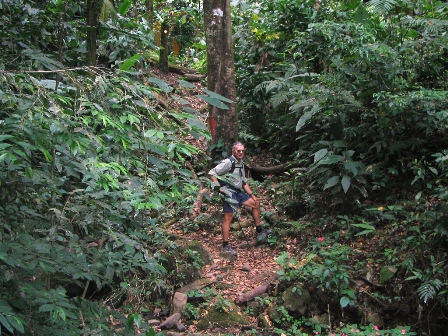 Finca
Esperanza Verde is a relatively new EcoResort started by
a Durham NC group and run locally by Nicaraguans in
nearby San Ramon, east of Matagalpa. It has already won
several awards for Ecotourism. All the profits go to aid
the local community. They can take up to 26 people in
small brick guesthouses set amongst an organic coffee
plantation. There is a small butterfly house and several
good walking trails, which of course we followed. Amongst
our fellow guests were two families from the diplomatic
community in Managua, a Canadian family with four
children and a Dutch family with three children. Finca
Esperanza Verde is a relatively new EcoResort started by
a Durham NC group and run locally by Nicaraguans in
nearby San Ramon, east of Matagalpa. It has already won
several awards for Ecotourism. All the profits go to aid
the local community. They can take up to 26 people in
small brick guesthouses set amongst an organic coffee
plantation. There is a small butterfly house and several
good walking trails, which of course we followed. Amongst
our fellow guests were two families from the diplomatic
community in Managua, a Canadian family with four
children and a Dutch family with three children.
We left with a few regrets and walked out to the bus
stop. To my chagrin, I realized I had forgotten to turn
in our room key. Being a conscientious person, I decided
to stop off in San Ramon and return the key to the local
office of the Finca. We knew we would have to wait for
the next bus going to Matagalpa, but we were either
waiting at the wrong place or the buses were on a break.
After nearly two hours, the Dutch family drove by on
their way home. Just as they were about to stop for us,
we realized they had a very flat tire. It took about 45
minutes, with the help of several helpful locals, to
change the tire. We of course gratefully accepted a ride
to Matagalpa where we retrieved the rest of our luggage
and found a bus heading for Masaya.
Masaya is not a particularly attractive town but it is
known for its artisan markets. A large tourist market sells
locally made hammocks, black pottery, leather goods and
painted wooden articles in nicely arranged booths. Most
of the goods were too big for us to carry home, so we
didn't buy much but it was interesting just looking. We
also visited the more traditional market in town. It was
so big it would be easy to get lost in the labyrinth of
stalls. Everything from meat, fruit and veggies, to
clothing and household goods could be purchased plus all
the same products for sale in the more plush tourist
market. It was a busy place.
Another
day we walked to El Coyotepe, a fortress built in 1893 on
top of a hill overlooking Masaya. The fortress, which is
now owned by the Boy Scouts, figured prominently in a
1912 stand against US intervention and during the
Nicaraguan revolution from the 1930s to 1983. We admired
the view of the countryside from the top of the
surrounding walls and walked through dark tunnels under
the walls. One of the Scouts on duty gave us a tour of
the dungeons under the central building. These were used
by Somoza's dreaded National Guard to house political
prisoners. We were told as many as 50 to 70 people were
kept in the largest room that was about 30 by 30 feet.
There were other tiny rooms for high risk prisoners. We
were glad our guide had a flashlight. It was dark and
scary in there.
Our last evening we walked to a local tienda (small
store) to buy bottled water. We couldn't get near the
store for the crowd of people in the middle of the street.
A brass band was playing as several locals carried two
platforms on their shoulders. Each town has a patron
Saint and this town had a mannequin dressed as a Virgin
Mary with a long lace train connected to a second float
carrying a young woman dressed in finery. The parade
stopped in front of the tienda and the crowd milled
around until prayers were said. The tienda owners came
out with drinks for the band members and the floats moved
on to the next small store.
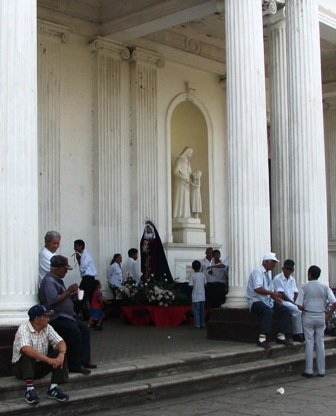 This
was just the first time we saw this scene enacted during
Semana Santa. Later in Granada, a procession carrying a
float, complete with fluorescent lighting and flashing
lights surrounding three mannequins of Saints and a glass
coffin with a figure of the crucified Christ inside made
its way down the street where we were staying. A hoard of
street vendors appeared first and wheeled their booths to
spots on the street where they could sell ice cream and
drinks to the following crowd. The float approached a
fire hall on the corner of the street, accompanied by a
brass band. Sirens blared out from the fire hall to greet
the Saints. The parade stopped, prayers were said, the
vendors packed up and ran ahead and the crowd moved on to
the next stop. This
was just the first time we saw this scene enacted during
Semana Santa. Later in Granada, a procession carrying a
float, complete with fluorescent lighting and flashing
lights surrounding three mannequins of Saints and a glass
coffin with a figure of the crucified Christ inside made
its way down the street where we were staying. A hoard of
street vendors appeared first and wheeled their booths to
spots on the street where they could sell ice cream and
drinks to the following crowd. The float approached a
fire hall on the corner of the street, accompanied by a
brass band. Sirens blared out from the fire hall to greet
the Saints. The parade stopped, prayers were said, the
vendors packed up and ran ahead and the crowd moved on to
the next stop.
Granada was an attractive city, much like Antigua in
Guatemala. Well kept Spanish colonial building surrounded
a treed central plaza lined with street vendors and small
outdoor cafes and crowded with families. It was
especially busy in Granada during the holiday period. For
the first time we had trouble getting a place to stay and
had to settle for a typical hostel. We did get a double
room, but it was hot in Granada and our little room was
steamy, in spite of the fan. We even tried to get a room
in a more expensive hotel but they were all booked for
Semana Santa, so we stayed where we were and suffered a
little.
Granada is on the
shore of the huge Lago Nicaragua. We walked down to have
a look. All we could see were bodies in the water and on
the 2 Km of beaches. It was packed with families taking
advantage of the Semana Santa holiday to cool off in the
lake waters. We were not tempted to join them but we
enjoyed the happy atmosphere.
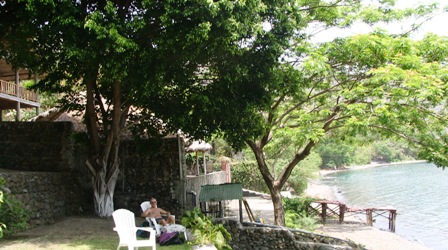 We stayed cool one day by
taking a bus out of town to nearby Laguna Apoyo, a
volcanic lake similar to Lago Atitlan in Guatemala, but
smaller. It is a dramatic ride from the rim of the crater
several Km down to the lake. The Bearded Monkey, our
hostel in Granada, owns a nice lakeside house where you
can stay or just visit for the day. Grassy terraces led
from the house to a dock for swimming. There were big
inner tubes for floating in the cool waters and a few
kayaks to try out. We had a great relaxing day just
swimming, sunning and reading. In fact, we are paying for
all that sun as we both got a little burnt. We stayed cool one day by
taking a bus out of town to nearby Laguna Apoyo, a
volcanic lake similar to Lago Atitlan in Guatemala, but
smaller. It is a dramatic ride from the rim of the crater
several Km down to the lake. The Bearded Monkey, our
hostel in Granada, owns a nice lakeside house where you
can stay or just visit for the day. Grassy terraces led
from the house to a dock for swimming. There were big
inner tubes for floating in the cool waters and a few
kayaks to try out. We had a great relaxing day just
swimming, sunning and reading. In fact, we are paying for
all that sun as we both got a little burnt.
About 1/2 Km farther down the lake was the public
beach and it was filled to capacity with people doing the
Semana Santa beach thing. We didn't want to return to
Granada until it had cooled down in late afternoon, so we
delayed leaving until nearly 5 PM, just at the same time
as the public beach was emptying. We should have taken a
taxi back to the highway where we would get a bus to
Granada but we didn't. We took the public bus along with
everyone else. We had a seat but I think there was a
record number of people crammed inside. It was a good
thing everyone was in a good mood.
That night brought a new element to the festivities. I
guess all the Saint blessings were over as the party
goers on the street after dark were adults and children
dressed in Carnival type costumes and dancing for
whomever would toss them a few coins.
We delayed leaving
Granada until Sunday, the last day of Semana Santa as we
didn't want to face more crowds at Isla de Ometepe in
Lago de Nicaragua, another favoured beach location. Isla
de Ometepe is shaped like a barbell. The round ends are
two volcanoes, Conception and the smaller Masera, joined
by a narrow isthmus of beach formed by volcanic runoff.
Lago de Nicaragua is connected to the Caribbean at one
end by a river. Long ago sharks made their way up this
river and some still live in the lake, although we saw no
evidence of them. There is a boat from Granada to
Ometepe, but the lake is especially windy, so we passed
up the rough four-hour trip in favour of a one hour boat
trip from the south side of the lake.
As soon as we reached Ometepe we headed for Playa
Venicia, a half-hour ride from the port. We stayed at a
nice beach hotel and spent most of the day reading in
hammocks. We did join four others from our hotel on an
excursion to walk up to a waterfall on Volcan Masera. The
start of the walk is only about 12 KM away but it took 1
1/2 hours to drive there in a minivan because the roads
were so bad. The roads from the port town of Moyogalpa
are gradually being rebuilt with interlock brick but they
have only completed just past Playa Venecia, about 1/8 of
the total distance. The bad roads do keep the tourist
population down, which is good for us but not the local
economy.
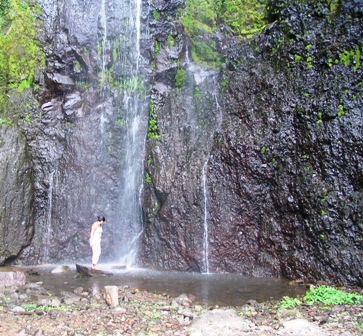 The trail to the
waterfall was on private property, owned by Estacion
Biological de Ometepe, which operates a hotel complex
that specializes in bringing International school and
college groups for a week studying tropical ecology,
birds and plants. We had a good, although sweaty 1 1/2
hour hike up to see a waterfall streaming down 35 M to a
small pool. We all disregarded a sign warning that rocks
could fall from the waterfall at any minute and splashed
cooling waters over ourselves. Once we were back down the
hill we cooled off again with a swim in the lake. The trail to the
waterfall was on private property, owned by Estacion
Biological de Ometepe, which operates a hotel complex
that specializes in bringing International school and
college groups for a week studying tropical ecology,
birds and plants. We had a good, although sweaty 1 1/2
hour hike up to see a waterfall streaming down 35 M to a
small pool. We all disregarded a sign warning that rocks
could fall from the waterfall at any minute and splashed
cooling waters over ourselves. Once we were back down the
hill we cooled off again with a swim in the lake.
Right next to our hotel on Playa Venicia is a nature
reserve, Laguna Chaco Verde. We had a nice walk around
the laguna, and up a hill for a view of Ometepe. There
were lots of raucous Urracas flying about. They are Blue
Jay cousins with a more elaborate feathered crest and a
longer tail than the northern Blue Jays.
We said goodbye to Nicaragua and headed for Costa Rica.
The border crossing was relatively easy once we figured
out where we had to go to pay exit fees and get stamped
out of Nicaragua then get accepted in Costa Rica. At
least there were no lineups.
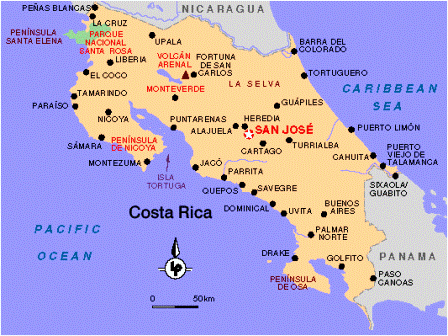
Click
the map above
to see an album of Costa Rica photos. Close the window to return
to this page. |
As soon as we were on the bus in Costa Rica we noticed
the relative prosperity of the country. Costa Rica has
highest standard of living in Central America and it
showed in the more substantial houses and neat yards.
Someone told us that apart from the well-developed
tourist industry, Costa Rica has more money to spend
because they do not maintain an army. In contrast,
Nicaragua and El Salvador have a high military budget to
contend with.
Our first stop was Liberia, a pleasant, prosperous
town but still too warm for our liking. There are now
direct flights from the US to Liberia, allowing more
tourists to start their visit in Liberia rather than the
capital, San Jose.
We had
planned to stay just overnight, but the hotel we stayed
at was offering an interesting trip to a National Park
nearby. Rincon de la Vieja is in the mountains just 21 Km
from Liberia but it took over an hour to get there
because of the rough roads. The park has several good
hiking trails but it isn't as popular as some of the
other tourist destinations in Costa Rica, so most of the
time we had the trails to ourselves. We had a three-hour
hike to a waterfall in the morning. It was a lovely trail
through the woods and through fields with views of the
mountains. The waterfall was worth the 1 1/2 hour walk.
It fell about 25 M into a pool deep enough to swim in. We
were too lazy to change into suits and contented
ourselves with splashing cold water on ourselves and
resting in the cool of the glade.
After returning to the park
entrance, we passed up the opportunity to climb to an
active volcanic crater. Instead we took a break to eat
lunch and started out on a second, shorter trail to see
thermal hot spots. Just at the entrance of the walk was a
Coati, a brown furry animal that looked like a cross
between a possum and a racoon. It ambled about poking in
the forest floor for bugs and wasn't in the least
disturbed by people following it about trying to take
photos.
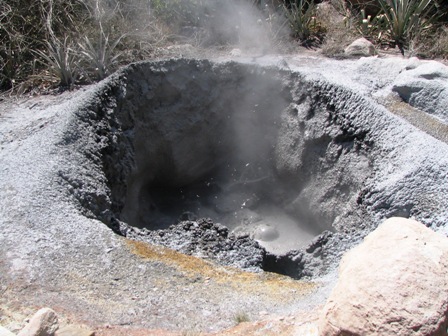
Fumarole in Rincon de la Vieja |
We finally left it alone and
walked through the woods to find the fumaroles. You could
smell the sulphur far before the steaming vents came into
view. There were several spots where volcanic gasses
bubbled up through pools of water and mud. They were all
far too hot for bathing as the temperature of the
fumaroles was near 200 C.
We have just arrived in the popular cloud forest park
of Monteverde, where I am finishing this Episode. We plan
to investigate more walking trails tomorrow with the hope
of seeing some tropical birds and animals.
|
